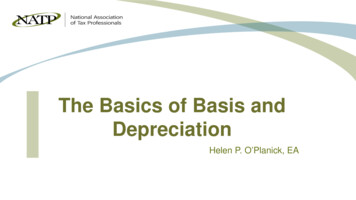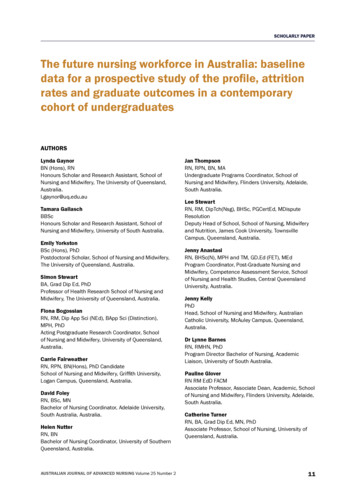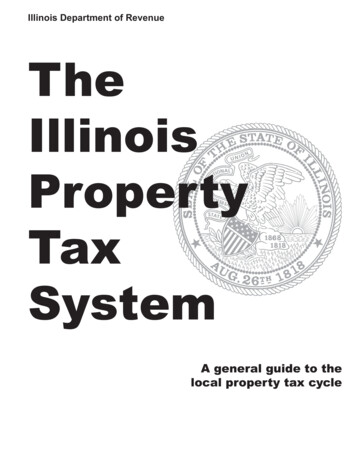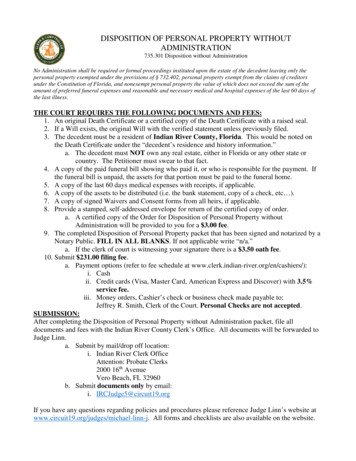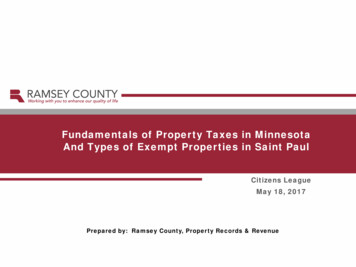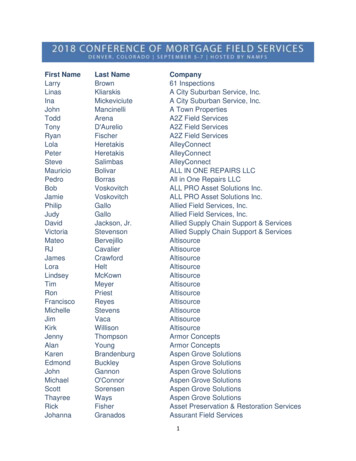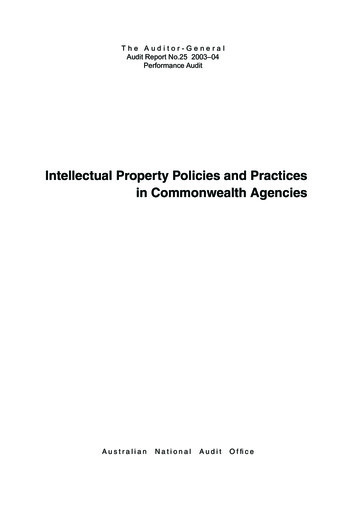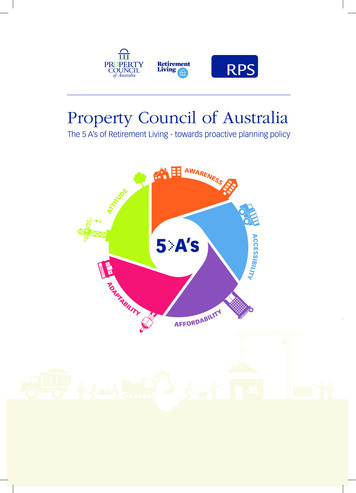
Transcription
Property Council of AustraliaThe 5 A’s of Retirement Living - towards proactive planning LITYA FF ORILDA BIT YAAw
Statement of LimitationPrepared for:Apart from fair dealing for the purposes of private study, research,criticism, or review as permitted under the Copyright Act, no partof this report, its attachments or appendices may be reproducedby any process without the written consent of RPS Australia EastPty Ltd. All enquiries should be directed to RPS Australia East PtyLtd or Property Council of Australia.We have prepared this report for the sole purposes of theProperty Council of Australia (“Client”) for the specific purpose ofreviewing retirement village related planning policy and makingpolicy recommendations (“Purpose”). This report is strictly limitedto the purpose and the facts and matters stated in it and doesnot apply directly or indirectly and will not be used for any otherapplication, purpose, use or matter.In preparing this report we have made certain assumptions. Wehave assumed that all information and documents provided tous by the Client or as a result of a specific request or enquirywere complete, accurate and up-to-date. Where we haveobtained information from a government register or database,we have assumed that the information is accurate. Where anassumption has been made, we have not made any independentinvestigations with respect to the matters the subject of thatassumption. We are not aware of any reason why any of theassumptions are incorrect.This report is presented without the assumption of a duty of careto any other person (other than the Client) (“Third Party”).AcknowledgementsThe Property Council of Australia and RPS would like to thank thefollowing groups for their contributions to the work in preparingthis report: Members of the Property Council of AustraliaRetirement Living Committees, members of the Retirement LivingCouncil, those who responded to the survey, and those memberswho contributed case studies.2The 5 A’s of Retirement Living - towards proactive planning policyProperty Council Of AustraliaLevel 1, 11 Barrack StreetSydney NSW 2000T: 61 2 6276 3603E: mwood@propertycouncil.com.auW: www.propertycouncil.com.auPrepared by:RPS Australia East Pty LtdDésirée Houston-Jones – Regional Technical Director743 Ann StreetFortitude Valley QLD 4006T: 61 7 3237 8899E: desiree.houston-jones@rpsgroup.com.auReport Number: PR122617-2
Contents1. Executive summary4Figures2. Roadmap8Figure 1– The 5A’s of Retirement Living– The Planning Issues63. Background and context9Figure 2– The 5A’s of Retirement Living– Proactive Planning policy7Figure 3– Key Features of State Level Planning Policy3.1 The statistics93.2 The ‘cohort’ - seniors93.3 Housing choices and policy support103.4 Regulatory layers103.5 Appropriately located housing choicesand ‘ageing in community’4. A planning policy response– why a state government response?5. Methodology101114Figure 4 – Cascading Policy Framework:Spectrum of Policy Effectiveness16Figure 5– Issues Matrix18Figure 6– Greatest Resistance in Legislation19Figure 7– State Department Jurisdiction19Figure 8– Major Land Use Competitors21Figure 9– Average Length of Stay2212Figure 10 – Influential Factors Affecting Retirement Living 235.1 Planning policy review12Figure 11 – Site Selection235.2 Survey12Figure 12 – Built Form of Existing Villages255.3 Interviews / committee workshops/ case studies12Figure 13 – States that Best Cater to RetirementLiving Development266. Key findings136.1 Policy review13Figure 14 – Planning Initiatives that Would SupportDevelopment306.2 Survey17Figure 15 – Influence of 5 A’s306.3 Key themes and common issues – the 5 A’s17Figure 16 – Spectrum of Policy Effectiveness– The Vision for 3 to 5 years337. Recommendations: a generic planningpolicy – strategic policy & regulatory8. Setting the target – assessing newinitiatives and monitoring progress27Table348.1 How? - Ongoing assessment and monitoring tools348.2 Setting the target349. Conclusions3510. Bibliography36Table 1 – 5 A’s Framework: A Generic Framework forProactive Planning Policy31AppendicesAppendix A: The 5 A’s of Retirement Living– The Planning Issues Explained37Appendix B: Outline of State and Territory Policiesand Instruments41The 5 A’s of Retirement Living - towards proactive planning policy3
Executive SummaryThe rapid increase in the number of older Australians needs to be matched by an increaseddetermination by politicians and town planners to support the development of more seniors housing.Purpose-built homes in retirement communities that are welllocated and designed to enable older Australians to be happy,independent and socially engaged is an important goal – but notone that our planning systems are well placed to achieve.Not every older Australian wants to live in a retirementcommunity, but they are a vital part of the housing mix, anddeliver choice. Almost 200 000 people – over 5% of seniorAustralians – live in retirement villages now. By 2025, the demandfor retirement living accommodation is forecast to double. But atthe current rate of development, there simply won’t be enoughretirement communities to meet consumer demand.This represents a huge missed opportunity for all governments,local, state and federal, because in addition to the increasedwellbeing of individuals who choose to live in seniors’communities, there is a very large saving for all levels ofgovernment that flows from this choice. Retirement villagesgenerate 2.16 billion of savings annually by delaying the entryof residents to aged care facilities, ensuring fewer and shorterhospital stays, fewer GP visits and savings through improvedsocial wellbeing.Land use policy is the single most important lever thatgovernments have to provide rapid support for the developmentof more retirement villages. From small to large, low densitytownhouses to multi storey apartments, all of the different builtforms are in demand in inner and middle ring suburbs of ourcapital cities, as well as in outer metropolitan areas and regionalcities.Australia’s current population of 3.2 million over 65s is projectedto be 8.1 million by 2050. In the medium term, by 2030, theAustralian Bureau of Statistics forecasts that over 19% of theentire Australian population will be older than 65. This largepopulation needs choice, so that every individual can make thedecision that is right for them about where and in what typeof home they live, the services they need, and the communitysetting that enables them to stay active, happy and asautonomous as possible.Villages are designed to support frail ageing bodies, andspecifically to reduce falls. Their design features (no or few stairs;wider corridors and emergency alert systems) eliminate triphazards, improve mobility, and allow residents to be assistedquickly. In addition to village staff, there is also a community ofpeers who support those who are hospitalised from time to timeto return home quickly.4The 5 A’s of Retirement Living - towards proactive planning policyIn addition to the reduced demand on aged care services andhospitals, villages also take a load off local infrastructure, asthis report shows. Small household sizes means less need forsewerage and water provisioning; fewer cars means less trafficand carpark demands; and the onsite amenities at retirementvillages often also means less need for ratepayer-fundedlibraries, community centres and sports facilities (bowling greens,swimming pools, golf courses etc).Despite these manifold social and economic benefits to localcommunities, what retirement villages are, who lives in them,and the role they play in the general community is very poorlyunderstood by many in government. As the report states:“there is a sense of bewilderment in the industry that retirementvillages have not reached the status of a national industry priorityreceiving direct and clear policy support” (Section 3.3).By comparison, aged care services enjoy significant subsidiesfrom government as well as a raft of land use and tax policysupport.All retirement village owners and developersneed is land use policy that supports, rather thanhinders, development.The retirement living industry faces a number of barriers inrespect to land use planning policy around Australia. Theprincipal one stems from the difficulty – and in many cases theimpossibility – of village developers competing with mainstreamresidential developers on the open market for land. Retirementvillage developers face a range of costs that general residentialdevelopers do not, including facilities that must be built inorder to meet the expectations of residents, but the demandreality is that most prospective residents are pensioners andexpect the upfront cost of the retirement village unit to be lessthan comparable properties in the area. Figure 1: The 5 A’sof Retirement Living – The Planning Issues summarises thesebarriers.
Executive SummaryThis report is the result of an extensive survey of State and Territory policy initiatives(standardised planning instruments, libraries or codes) as well as a survey of Property Councilmembers, representing over 300 retirement village developments across Australia.The common planning related problems that arise from this twotiered analysis provide a framework for generic planning policythat supports more retirement community developments. Theframework is generic so it is a consistent policy platform acrossall jurisdictions, and can be applied simply to the specific planninginstruments in each state.There is a clear need to improve awareness and develop aproactive attitude at council level about the retirement livingsector. In addition to this – and as a way of achieving it - the keypolicy recommendations in this report are:OFRETIREMENTVILLAGEDEVELOPERSsurveyed for this researchconsider that land use planninghas a positive role to play inretirement living development.Author’s Note:With eight state and territory governmentsand over 500 local governments, planningframeworks, schemes and policies areconstantly evolving, being reviewed, andbeing replaced with newer documents. Theresearch, meetings and surveys used tocreate this report were undertaken in 2014. Zoning - support for retirement villages in a wider range ofzones Incentives - policy incentives to improve development yields(from plot ratios to flexible carpark provisioning) Infrastructure - trunk infrastructure credits for open spaceand recreation facilities Assessment timeframes - easier and faster assessmentpaths to approval Dwelling targets - set retirement living dwelling targetsbased on local demographics Outcome focused planning provisions – lessprescription about design features for the village, to ensuredevelopments are responsive to market needs.Figure 2: The 5 A’s of Retirement Living – Proactive PlanningPolicy provides further detail.Australia has a shortage of housing builtspecifically to meet older people’s needs.Regulation of the business model for retirementvillages through state laws already constrain thesector’s capacity to respond to the increaseddemand for this type of housing, but State andTerritory Governments have the reform levers tolead change through proactive land use policy.This report focuses on the net communitybenefit from undertaking these reforms.Mary WoodExecutive Director – Retirement LivingProperty Council of AustraliaThe 5 A’s of Retirement Living - towards proactive planning policy5
AWARENESSFigure 1: The Planning IssuesBased on industry feedback there are essentially fivecommon themes that capture the key planning issuesfor retirement village development. These commonthemes relate to awareness, accessibility,affordability, adaptability and attitude.ATTITUDEA’sACCESSIBILITYOF RETIREMENTLIVINGADAPTABILITYAFFORDABILITYA AWARENESSA ACCESSIBILITYA AFFORDABILITYA lack of breadth and depth inunderstanding by all levels ofgovernment and the communityregarding what retirement livingdevelopment is, its operational, marketdrivers and social imperatives, andimportantly how it is different to standardresidential development or aged care.The difficulty retirement village providershave in acquiring sites in appropriatelocations when competing on theopen market, where market value isdominated by the ‘highest and best’ useof the land. Numerous factors reduce thesector’s ability to achieve a ‘highest andbest’ land use status required to contendand therefore access and acquireappropriate sites in suitable locations.Issues of affordability relate to the arrayof additional cost imposts (includingupfront costs) and unique driverswhen compared to typical residentialdevelopment; such as non-binding presales of dwellings, the ‘downsizing’ andtherefore price point expectations of thetarget market and the regulated financialmodel imposed under the various stateand territory retirement village regulatorylegislation.A ADAPTABILITYA ATTITUDEThe dominance and inflexibility of the‘one size fits all’ approach to designand development planning provisionsoften captures seniors housing as wellas people with disabilities. This alsoinvolves the often stringent enforcementof prescriptive accessibility / mobilityprovisions rather than allowing theprovider to design for the future retrofitof such aides as and when need arises.Adaptability also relates to the needfor flexibility and adaptability in policyto respond best to the market andopportunities, including the re-generation/ re-development of existing villagesand the opportunities those sites offerfor additional dwellings in often wellserviced locations.The culture and attitude of the relevantlocal government can trump everything!This can overcome otherwise unhelpfulplanning policy but equally causesubstantial delays, cost and evenwithdrawal from projects where alocal government is adversarial andunsupportive of development. Theattitude and approach to retirementliving, development assessmentof projects, particularly by localgovernment, has a massive impact onthe likelihood of achieving reasonableapprovals in reasonable timeframes.This is of course true for the entiredevelopment industry.OFDEVELOPERShave pulled out of retirementprojects with unsupportivedevelopment provisions/standards being a key reason.Source: Retirement Living Industry Survey, RPS, 20146The 5 A’s of Retirement Living - towards proactive planning policy
Figure 2: ProactivePlanning Policy – KeyRecommendationsThe retirement living industryis willing to work withgovernments to implementthese changes.AWARENESSACCESSIBILITY1. Improve understanding of stateand local governments about whatretirement villages are and aren’t, sothat Australia is well placed to respondto the need for more age appropriatehousing for its growing seniors’population.3. Make retirement living a‘permissible’/‘accepted’ developmentin all residential and appropriateCommunity Use zones.2. Amend state or regional/metroplanning instruments or guidelines to:AWARENESSATTITUDEA’sACCESSIBILITYOF RETIREMENT Insert an explanation of what aretirement living community is Establish retirement living dwellingtargets based on demographic data5. Streamline the planning processfor retirement living developments,for example, by enabling fast-trackapproval processes for retirementfacilities such as ‘Risksmart’ inBrisbane. Outline preferred design requirements,particularly for multi-storeydevelopment6. Identify how to make more suitableland available for the development ofretirement living communities. Remove obstacles to the integrationand co-location of villages withcommunity facilities and other uses,such as aged care, medical facilitiesand convenience retail or 7. Implement a suite of developmentbonuses/ incentives for retirementliving developments, including plotratio, site area, height, setbacks,carparking flexibility, and landscapearea reductions.8. Implement trunk infrastructurecredits for open space, recreationand community facility wheredevelopments provide specifiedprivate, communal open space orcommunity facilities.9. Exempt or subsidise infrastructurecharging for retirement villages.10. Give rate rebates for retirement livingdwellings.11. Establish performance based designoutcomes, not prescriptive outcomes.4. Remove the need for public advertisingand appeal rights from 12. Permit dwellings to be adaptable tofuture accessibility needs rather thanmandate upfront the construction ofthese features.15. Lead from the top. Introduce culturalchange programs across the state that:13. Articulate design guidance rather thanmandated outcomes for retirementvillages e.g. Infill Development for OlderAustralians in South East Qld or NSWSilver or Gold Liveable Housing DesignGuidelines.14. Facilitate and incentivise theredevelopment and regeneration ofexisting retirement villages throughsupportive zoning and developmentconditions. Acknowledge the role of retirementvillages in providing housing andchoice to seniors as well as theeconomic and social contribution ofvillages to the wider community Acknowledge the role of governmentin proactively facilitating the supply ofretirement living housing Ensure retirement village facilitationis the responsibility of state HousingDepartments Establish state-wide incentives andpolicy positions within standardisedinstruments and libraries which aremandatory for local governmentinclusion in local plans and planningschemes.The 5 A’s of Retirement Living - towards proactive planning policy7
RoadmapThis report reviews the state government and regional level planning policy that is directly relevant toretirement villages, and the degree such policies do or do not facilitate retirement village development.It outlines industry views gained through various collectionmethods (survey, workshops, interviews and case studies).Based on the national policy review andindustry feedback, five key themes - The 5 A’sof Retirement Living - were developed whichcapture the common planning and approvalproblems facing the industry. From these keythemes a generic strategic policy and regulatorystate level planning framework is suggested,which ensures that land use planning isfacilitating rather than hindering retirementvillage development.In addition, a number of resources have been developed foruse by the industry in improving understanding of the nature ofretirement living developments and the planning related issuesfaced.The resources contained within this report include: The 5 A’s of Retirement Living – The Planning Issues(Figure 1) provides a graphic summary of the planning issueswhich affect the retirement living sector. These issues areoutlined in greater detail as a separate resource in AppendixA - The 5 A’s of Retirement Living – The Planning IssuesExplained. Outline of State and Territory Policies and Instruments(Appendix B) provides a table which outlines the relevantexisting policies and instruments for each of the states andterritories. The far right column of the table considers howthe policy recommendations from this report align with theexisting state/territory policy framework. Cascading Policy Framework - Spectrum of PolicyEffectiveness (Appendix C) provides a description of thosegeneric features that could be considered to constitute Low,Medium and High levels of policy effectiveness. This spectrumcan be used to assess if a state instrument or even localgovernment instrument has moved along the spectrum todeliver a better policy outcome. The 5 A’s of Retirement Living – Proactive PlanningPolicy (Figure 2) can be used by advocates as a base linepolicy aspiration. This is a graphic summary of the moredetailed recommended policy framework presented in The 5A’s Framework – A Generic Framework for Proactive PlanningPolicy (Table 1). Refer to Section 7: Recommendations: AGeneric Planning Policy – Strategic Policy and Regulatory, forfurther details and explanation.8The 5 A’s of Retirement Living - towards proactive planning policy
Background and ContextThe Australian demographic is changing, with the population aged 65 years and over projected toincrease from 14% at 30 June 2012 to between 18.3% and 19.4% in 2031. (ABS, 2013, para. 38).Retirement village development sits within the larger puzzle of‘housing choice for an ageing population’. Key influencers aregovernment support for housing options; pension settings, particularly treatment of home equity; regulations which impact upondevelopment; the interface between property and wellbeing/care;and the clear benefits of facilitating a common desire to ‘age inthe community’.3.23.1 Seven out of the top ten reasons for choosing the villageaccommodation option were physical (health related).Statistical OverviewIn 2010 approximately 5.3% of Australians aged over 65 wereliving in retirement villages (Productivity Commission, 2011). In2014, this had increased to approximately 5.7% or 184,000, ofAustralians aged over 65 (Grant Thornton, 2014, p. 5). In six years from 2006 to 2012, the net increase in personsaged between 65–74 years more than doubled (150%) froma 40,000 annual increase to a 100,000 annual increase(MacroPlan DimasiPlan, 2014). The impacts of this 150% increase have been delayed but willbe evident in 2015–2017. The delay is due to an increase inpeople working to an older age, the quantum of casual andpart-time jobs and the increase in the number of Australianswith superannuation (MacroPlan Dimasi, 2014). By 2025, it is projected that 7.5% (or 382,000) of olderAustralians will want to live in retirement villages. This is morethan double the current number (Grant Thornton, 2014, p. i). By 2050, 8.1 million Australians will be over 65 and lookingfor housing options that are age appropriate and in suitablelocations (Grant Thornton, 2014, p. i).As seniors age, they require a range of health, community andhousing choices. Retirement villages provide one option for seniorAustralians, who want to live independently but in a community,with support services available onsite or nearby.The ‘Cohort’ - SeniorsPolicy often defines seniors as people over 50 or 55 years of age,however statistical analysis often considers seniors to be thoseaged 65 and over. By comparison, people entering retirementvillages have an average age of 75 . Other characteristics of theseniors cohort entering retirement villages include: The top three reasons residents chose to leave their previoushome (push factors) was to downsize while they could -theirhome was becoming too big to manage, and freedom fromhouse responsibilities meant being able to pursue otherinterests. The top three village residents chose their particular village(pull factors) were because they could stay independent,in a safe environment with emergency support and onsitemaintenance. Residents generally felt that most services and features wereoffered by their village, however areas for potential growthincluded the provision of visiting doctor or medical services,and a village bus for external activities such as shopping andoutings. Village residents are mostly satisfied that their expectationshave been met, with 65% indicating this. Furthermore, 75%were happy with their decision to move into their village andwould make the decision again. Overall, most residents felt financially secure to meet boththeir current and future financial needs. Furthermore, amajority felt that their decision to move into a village had beena good financial decision (90%). Village residents had positive experiences with village living,with half (50%) stating that their overall life satisfaction andhappiness had improved since moving in.(McCrindle Baynes, 2013, p. 4–6).The 5 A’s of Retirement Living - towards proactive planning policy9
Background and Context3.3Housing Choices and Policy Support3.5There are a range of housing choices available to seniors, including: Staying in the family home Downsizing to an apartment within a standard residentialdevelopment Retirement villages Relocatable homes parks (also called lifestyle or manufacturedhome parks) Residential aged care Living with adult children/relatives.All of these options are important and providehousing choice to seniors. All have some levelof policy support, or no regulatory barriers, withthe exception of retirement villages.For example: Seniors are encouraged to remain in their homes bythe ‘ageing in place’ Home Care Packages and Homeand Community Care Packages funded by the FederalGovernment. Relocatable home parks have a less regulated financial modelthan the Retirement Villages Acts.Appropriately Located Housing Choices and‘Ageing in Community’The location of the current range of retirement villages isgenerally well matched with the needs of current residents,with 79% of new residents moving to a village that was withintheir expected range (McCrindle Baynes, 2013). This level ofsatisfaction may decline over time as many new retirementvillages are in urban fringe locations, whereas most over 65s livein the inner and middle ring suburbs (MacroPlan Dimasi 2014).The ability of residents to relocate within their own communityis a laudable goal that will maintain social networks. It isrecognised that there are other drivers which encourage someseniors to move out of their communities e.g. to relocate neargrandchildren, however remaining within one’s community is amore dominant driver of location.Based on industry feedback gathered for this report, thereis debate within the industry that the federal government’spolicy focus of ‘ageing in place’ causes seniors to remain intheir family homes even where those homes do not supportchanging physical needs. Furthermore seniors can experienceisolation and depression where policy discourages a move tomore appropriate housing with peer support. The retirementliving sector recognises the importance of providing well-locatedvillages where seniors can age in place or within their communityin an age adaptive home. Standard residential apartments are commonplace,understood by the market and unencumbered by a regulatedfinancial model.1 Aged care enjoys federal government support as well as a raftof land use and tax policy supports. From the discussions and workshops undertaken during thisresearch, there is a sense of bewilderment in the industry thatretirement villages have not reached the status of a nationalindustry priority receiving direct and clear policy support.Australians over 65 who satisfy either the income or assetstest for the age pension are eligible to receive it. The full rate ofpension is payable under the asset test for homeowners whohave total assets (excluding principal place of residence) of lessthan 202 000 ( 286,500 for a couple combined). For single pensioners who have more than 202 000 of assets,their pension is reduced by 1.50 per fortnight for every 1000of assets over the threshold (known as the ‘taper rate’). E.g., ifa pensioner with assets close to the threshold downsizes, andmakes a cash surplus of 150 000 from selling her family homeand buying a smaller place, her pension would be cut by 5850pa. This acts as a penalty, and means that most pensioners whowish to downsize choose not to. A survey of more than 2000 Australians over 50 by NationalSeniors in 2014 showed that 30% of pensioners who areconsidering downsizing see the pension means test as asignificant barrier. 1.39 million or 59% of all pensioners receive the full pension, withthis number expected to increase over time. 75.1% of pensioners own their home, and 1.11 million pensionersare over 75 (a combination of full and part rate pensions).3.4A review of the respective state and territory retirement villageActs was not within scope, however it is clear from industryfeedback that the regulated financial model/s embeddedin legislation constrains flexibility and innovation in offeringhousing choice to seniors. These instruments establish financial,contractual and management models within which retirementvillages must operate. The Acts do not relate to land use planningpolicy, though they do impact on the feasibility of a retirementvillage development.10.The Problem:Regulatory LayersThe factors that influence the retirement living sector’s abilityto provide appropriate housing in suitable locations are many,complex and interrelated. These factors include property andasset taxation regimes, healthcare and aged care systems,pension thresholds and means tests1, regulation of retirementliving communities (i.e. the Retirement Village Acts in eachjurisdiction), as well as housing and land use planning policy.The 5 A’s of Retirement Living - towards proactive planning policyProperty Council of Australia, 2015:Note: The 2015 Federal budget proposed to make changes, effectiveJanuary 2017, to the asset test threshold and taper rate.
A Planning Policy Response– Why a state government response?100% OF RESPONDENTSbelieve retirement living should be directly referenced in land use policiesThe common planning related problems provide a framework for a generic planning policy thatsupports development.The framework is generic so it is a consistent policy platform across alljurisdictions and can be applied to the specific planning instruments in each state.A state government response to the land use planning issuesidentified by the industry - articulated in this report - is necessarygiven the factors listed below. In the majority of states, stategovernment policy, including standardised local plan or planningscheme instruments/libraries, are the basis for the developmentof local planning schemes by local government. This hierarchy ofplanning jurisdictions and instruments together with the matterslisted below means the state and territory governments havethe greatest potential to affect broad, integrated change. Thisdoes not detract for the need for leadership to be shown by localgovernments.Why a state and t
The matters listed in Section 6.3.2, being the additional cost imposts which affect site acquisition, are all matters that affect the ability to produce affordable product. . not need or want such mobility and accessibility aides at the time of moving in. Figure 12 - Built Form of Existing Villages Villages with five or more floors are .

